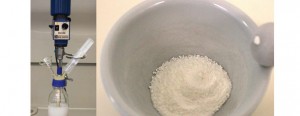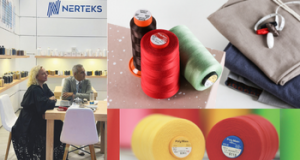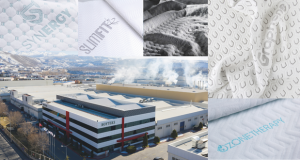 Scientists develop wash-resistant antimicrobial treatment for protein fibers
Scientists develop wash-resistant antimicrobial treatment for protein fibers
BÖNNIGHEIM – As part of an IGF research project, scientists at the Hohenstein Institute in Bönnigheim and the Leibnitz Institute for Interactive Materials in Aachen have developed an antimicrobial treatment for wool and other textiles containing wool. Many of the antimicrobial treatment substances available on the market today are very effective on cotton, polyester, polyamide and those kinds of mixtures of fibers. By contrast, antimicrobial substances are often not effective at all, or only to a very limited extent, on wool and mixed fibers containing wool. And yet an antimicrobial protective treatment would be particularly desirable here, because textiles containing wool are generally washed less frequently than textiles made from other fibers, due to the felting tendency of woolen fibers. Especially in the outdoor and sports sectors, wool is currently experiencing a real renaissance, so Mihaela Szegedi, Project Leader at the Hohenstein Institute, sees that as a particularly attractive area of application for this innovative textile finish: “By combining the use of different antimicrobial substances and technologies, we have achieved a really wide range of effectiveness. This will be especially of interest to manufacturers of high-quality functional textiles containing wool. However, we also see great potential for classic business suits or ladies’ suits made of wool or mixed fabrics containing wool, as well as domestic and furnishing textiles.” To find the best formulation, the researchers studied the combined use of ionic biopolymers, cationic polyelectrolytes, materials like silver and zinc and technologies such as “layer-by-layer” coating. The two research institutions pursued two different approaches in parallel. At the Hohenstein Institute, researchers concentrated on producing a colloidal dispersion of mixed substances (a colloidal complex) in an aqueous dispersion medium. This is what a suspension is called in which the antimicrobial particles (1nm < size > 1μm) consist of two substances: the ionic biopolymer alginate (SA) and a type of silane quat (the cationic tetraoctadecyl silicon ammonium compound (TSA)). The experts at the Hohenstein Institute worked out the best ratio for the concentration of the two components, SA:TSA, and how to find the best way of applying and fixing ultra-thin layers to textile substrates. The DWI developed a hydrogel coating made of polyamines and silver colloids and studied the effectiveness of the silver-release layers that were produced in situ in the treatment of pure woolen fabric and in fiber mixes. Following a two-stage gel cross-linking reaction to produce the colloidal complex (Figures 1a and 1b) from different SA:TSA % weight ratios, the antimicrobial effectiveness of the SA/TSA colloidal complexes was studied. The interaction with the fiber substrates was tested by measuring zeta potential and the pre-prototype was optimized to improve wash permanence. By using application techniques such as high-temperature exhaust and cold-pad-batch processes, followed by drying/fixing, alternating layers of the polyamine hydrogel, the silver colloids and the polyelectrolyte layers (SA, TSA) were applied and the range of effectiveness was evaluated at both research centers using different assessment matrices. The tests showed that by combining two active components (silver ions and Si- quats) the growth of microorganisms (bacteria and fungi) on wool and on wool and polyester blends could be greatly reduced. The application of silver-release layers (Ag/ polyamine), polyelectrolyte (SA) and Si-quat layers (TSA) resulted in a finish that had a synergistic effect. The disadvantages of a combined treatment based on silver-release layers and alternating polyelectrolyte layers are discoloring and limited wash permanence. In the research project, a treatment based on colloidal complexes was developed for the first time specifically for wool and WO and PET fiber blends. By applying colloidal layers of the SA/TSA complex (in a 1:2 ratio), together with a colloidal zinc- pyrithione formulation over the sol-gel coating, a strong antimicrobial effect was achieved which lasted even after 25 wash cycles (Figure 3). Here, too, in addition to the wash permanence, a wider spectrum of effectiveness against bacteria and fungi was noted as a result of combining the two active components. It was found that the effectiveness against Gram-positive and Gram-negative bioindicators can be increased by a higher proportion of TSA. Analysis by dynamic light scattering (DLS) and ATR-IR spectroscopy indicates that the interaction of the anionic polyelectrolyte SA with the TSA silane-quat components leads to the formation of colloidal structures (micelles) or silesquioxane oligomers as a result of electrostatic interactions. Combining the use of the aqueous SA/TSA complex and colloidal silver in an exhaust process, or of commercial zinc-based colloids in a Foulard process, leads to a wide range of effectiveness and excellent hygiene protection for products containing wool. This means that products based on animal protein fibers can be protected against the destructive effect of fungi, algae and bacteria. Woolen textiles that are frequently exposed to moisture can also be protected by this treatment from material damage such as mold or rotting. This kind of synergistic treatment for textiles with a high woolen fiber content can be of great benefit to textile manufacturers (domestic textiles, upholstery materials), insulation producers, hosiery manufacturers and other fabric producers. Companies in the technical textile sector, whose product range includes woolen fiber blends (car seats), will also be able to benefit from the advantages of antimicrobial protection. The specific formulations that are used are already licensed under the EU Biocidal Products Regulation and can therefore be used as a combined treatment (based on aqueous colloidal dispersions) by textile finishing companies.
 SleepTech Magazine Mattress, Accessories, Machinery, Raw Materials
SleepTech Magazine Mattress, Accessories, Machinery, Raw Materials


